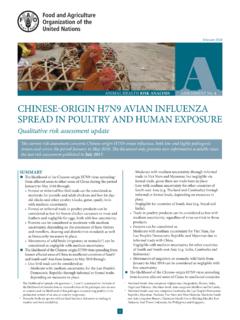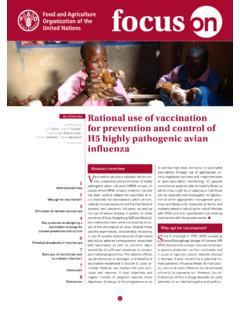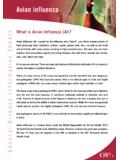Transcription of Highly pathogenic avian influenza - Home: OIE
1 Rev. sci. tech. Off. int. Epiz., 2000,19 (2), 463-482 Highly pathogenic avian influenza Swayne & Suarez Southeast Poultry Research Laboratory, Agricultural Research Service, United States Department of Agriculture, 934 College Station Road, Athens, Georgia 30605, United States of America Summary Highly pathogenic (HP) avian influenza (Al) (HPAI) is an extremely contagious, multi-organ systemic disease of poultry leading to high mortality, and caused by some H5 and H7 subtypes of type A influenza virus, family Orthomyxoviridae. However, most Al virus strains are mildly pathogenic (MP) and produce either subclinical infections or respiratory and/or reproductive diseases in a variety of domestic and wild bird species.
2 Highly pathogenic avian influenza is a List A disease of the Office International des Epizooties, while MPAI is neither a List A nor List B disease. Eighteen outbreaks of HPAI have been documented since the identification of Al virus as the cause of fowl plague in 1955. Mildly pathogenic avian influenza viruses are maintained in wild aquatic bird reservoirs, occasionally crossing over to domestic poultry and causing outbreaks of mild disease. Highly pathogenic avian influenza viruses do not have a recognised wild bird reservoir, but can occasionally be isolated from wild birds during outbreaks in domestic poultry.
3 Highly pathogenic avian influenza viruses have been documented to arise from MPAI viruses through mutations in the haemagglutinin surface protein. Prevention of exposure to the virus and eradication are the accepted methods for dealing with HPAI. Control programmes, which imply allowing a low incidence of infection, are not an acceptable method for managing HPAI, but have been used during some outbreaks of MPAI. The components of a strategy to deal with MPAI or HPAI include surveillance and diagnosis, biosecurity, education, quarantine and depopulation. Vaccination has been used in some control and eradication programmes for Al.
4 Keywords avian diseases - Fowl pest - Fowl plague - Highly pathogenic avian influenza -Orthomyxoviruses. Introduction Highly pathogenic (HP) avian influenza (AI) is an extremely infectious, systemic viral disease of poultry that produces high mortality and necrobiotic, haemorrhagic or inflammatory lesions in multiple visceral organs, the brain and skin (4,103). Highly pathogenic avian influenza and fowl plague are synonymous terms, the latter being the historical designation for the disease originally described in domestic fowl (Gallus gallus domesticus), and the former the more accurate currently accepted name for the disease in all bird species (12, 73).
5 Fowl plague has been known by other names including fowl pest (peste aviaire), Gefl gelpest, Brunswick bird plague, Brunswick disease, fowl disease, and fowl or bird grippe (98). History Fowl plague was first reported in Italy in 1878 by Perroncito who described a severe, rapidly spreading disease that produced high mortality in chickens (98). In 1880, Rivolto and Delprato differentiated fowl plague from the clinically similar septicaemic form of fowl cholera and used the name typhus exudatious gallinarium to describe fowl plague (98). The disease spread throughout Europe in the late 1800s and early 1900s via poultry exhibitions and shows, where it became endemic in domestic poultry until the 1930s.
6 In 1901, the cause was determined to be a filterable agent, a virus, although only in 1955 was the virus identified and classified as Type A influenza virus (orthomyxovirus), and shown to be related to other influenza viruses that commonly 464 Rev. sci. tech. Off. int. Epiz., 19 (2) infected humans, pigs and horses (82). From the 1960s onwards, a variety of influenza viruses were isolated from turkeys with milder disease ( non-fowl plague syndromes), and these viruses were termed mildly pathogenic (MP)-AI viruses or AI viruses of low pathogenicity (108). The agar gel immunodiffusion (AGID) test became the international standard for serological diagnosis and surveillance (16).
7 In 1972, wild waterfowl of the order Anseriformes (ducks and geese) were demonstrated to be a principal reservoir and the natural host for MPAI viruses (90). In 1979, the cleavability of the haemagglutinin (HA) protein was identified as the major determinant of virulence in HPAI viruses (21). In 1981, the first International Symposium on avian influenza was convened in Beltsville, Maryland, United States of America (USA), and the term 'fowl plague' was abandoned for the more accurate term ' Highly pathogenic avian influenza ' (12). avian influenza virus Description of the aetiological agent avian influenza viruses are negative sense, segmented, ribonucleic acid viruses of the family Orthomyxoviridae.
8 The Orthomyxoviridae family includes several segmented viruses including the Type A, B and C influenza viruses. The Type A influenza viruses, which include all AI viruses, can infect a wide variety of animals including wild ducks, chickens, turkeys, pigs, horses, mink, seals and humans. The type B and C viruses primarily infect only humans and occasionally pigs. The different types of influenza viruses can be differentiated serologically based on antigenic differences in the conserved internal proteins, primarily the nucleoprotein and matrix genes, using the AGID test (16). Type A influenza viruses have eight gene segments that encode ten different proteins (56).
9 The proteins can be divided into surface proteins and internal proteins. The surface proteins include the HA, neuraminidase (NA) and matrix 2 proteins. The HA and NA proteins provide the most important antigenic sites for the production of a protective immune response, primarily in the form of neutralising antibody. However, these proteins have large antigenic variation, with fifteen HA and nine NA subtypes being recognised, based on haemagglutination-inhibition (HI) and neuraminidase-inhibition (NI) tests, respectively. The internal proteins include the polymerase complex, including the three polymerase proteins (PB1, PB2 and PA), the nucleoprotein, the matrix 1 protein, and non-structural proteins 1 and 2.
10 Definition of pathogenicity The pathogenicity of individual AI viruses varies and should be determined in order to develop prevention, control and eradication strategies. The usage of the term HP implies that the virus is Highly virulent for chickens and has been demonstrated to meet one or more of the following three criteria (72, 115): a) any influenza virus that is lethal for six, seven or eight of eight (>75%) four- to six-week-old susceptible chickens within ten days following intravenous inoculation with ml of a 1:10 dilution of a bacteria-free, infectious allantoic fluid b) any H5 or H7 virus that does not meet the criteria in a), but has an amino acid sequence at the HA cleavage site that is compatible with HPAI viruses c) any influenza virus that is not an H5 or H7 subtype and that kills one to five of eight inoculated chickens and grows in cell culture in the absence of trypsin.














